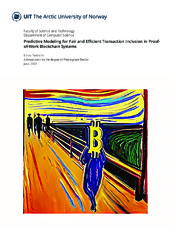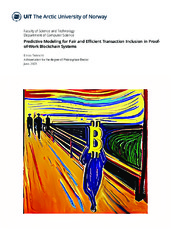| dc.contributor.advisor | Dagenborg, Håvard | |
| dc.contributor.author | Tedeschi, Enrico | |
| dc.date.accessioned | 2023-09-20T11:07:03Z | |
| dc.date.available | 2023-09-20T11:07:03Z | |
| dc.date.issued | 2023-10-02 | |
| dc.description.abstract | This dissertation investigates the strategic integration of Proof-of-Work(PoW)-based blockchains and ML models to improve transaction inclusion, and consequently molding transaction fees, for clients using cryptocurrencies such as Bitcoin. The research begins with an in-depth exploration of the Bitcoin fee market, focusing on the interdependence between users and miners, and the emergence of a fee market in PoW-based blockchains. Our observations are used to formalize a transaction inclusion pattern. To support our research, we developed the Blockchain Analytics System (BAS) to acquire, store, and pre-process a local dataset of the Bitcoin blockchain. BAS employs various methods for data acquisition, including web scraping, web browser APIs, and direct access to the blockchain using Bitcoin Core software. We utilize time-series data analysis as a tool for predicting future trends, and transactions are sampled on a monthly basis with a fixed interval, incorporating a notion of relative time represented by block-creation epochs.
We create a comprehensive model for transaction inclusion in a PoW-based blockchain system, with a focus on factors of revenue and fairness. Revenue serves as an incentive for miners to participate in the network and validate transactions, while fairness ensures equal opportunity for all users to have their transactions included upon paying an adequate fee value. The ML architecture used for prediction consists of three critical stages: the ingestion engine, the pre-processing stage, and the ML model. The ingestion engine processes and transforms raw data obtained from the blockchain, while the pre-processing phase transforms the data further into a suitable form for analysis, including feature extraction and additional data processing to generate a complete dataset. Our ML model showcases its effectiveness in predicting transaction inclusion, with an accuracy of more than 90%. Such a model enables users to save at least 10% on transaction fees while maintaining a likelihood of inclusion above 80%. Furthermore, adopting such model based on fairness and revenue, demonstrates that miners' average loss is never higher than 1.3%.
Our research proves the efficacy of a formal transaction inclusion model and ML prototype in predicting transaction inclusion. The insights gained from our study shed light on the underlying mechanisms governing miners' decisions, improving the overall user experience, and enhancing the trust and reliability of cryptocurrencies. Consequently, this enables Bitcoin users to better select suitable fees and predict transaction inclusion with notable precision, contributing to the continued growth and adoption of cryptocurrencies. | en_US |
| dc.description.doctoraltype | ph.d. | en_US |
| dc.description.popularabstract | This research utilizes the power of AI to predict the inclusion of transactions in the blockchain, thereby reducing fees and promoting fairness among users. By harnessing the insights provided by our predictive model, individuals gain the ability to make informed decisions about their transactions, ensuring optimal cost-effectiveness while maintaining a high probability of successful inclusion.
The impact of this work extends beyond individual users. It contributes to building trust and confidence in cryptocurrencies, highlighting their potential as reliable and efficient digital assets. By shedding light on the underlying mechanisms governing miners' decisions, this research enhances the overall user experience and fosters wider adoption of cryptocurrencies in various aspects of our modern economy.
The findings and advancements achieved through this research pave the way for a more secure, accessible, and equitable financial ecosystem. By empowering users to navigate transaction fees with greater precision and transparency, we can facilitate the continued growth and acceptance of cryptocurrencies in our rapidly evolving digital world. | en_US |
| dc.description.sponsorship | The Norwegian Research council | en_US |
| dc.identifier.isbn | 978-82-8236-538-3 (printed version) | |
| dc.identifier.isbn | 978-82-8236-539-0 (electronic/pdf version) | |
| dc.identifier.uri | https://hdl.handle.net/10037/31116 | |
| dc.language.iso | eng | en_US |
| dc.publisher | UiT Norges arktiske universitet | en_US |
| dc.publisher | UiT The Arctic University of Norway | en_US |
| dc.relation.haspart | <p>Paper I: Tedeschi, E., Johansen, H.D. & Johansen, D. (2018). Trading Network Performance for Cash in the Bitcoin Blockchain. <i>CLOSER 2018, the 8th International Conference on Cloud Computing and Services Science</i>, 643-650. Also available at <a href=https://dx.doi.org/10.5220/0006805906430650>https://dx.doi.org/10.5220/0006805906430650</a>.
<p>Paper II: Tedeschi, E., Nordmo, T.S., Johansen, D. & Johansen, H.D. (2019). Predicting Transaction Latency with Deep Learning in Proof-of-Work Blockchains. <i>2019 IEEE International Conference on Big Data (Big Data)</i>, 4223-4231. Published version not available in Munin due to publisher’s restrictions. Published version available at <a href=https://doi.org/10.1109/BigData47090.2019.9006228> https://doi.org/10.1109/BigData47090.2019.9006228</a>. Accepted manuscript version available in Munin at <a href= https://hdl.handle.net/10037/17954> https://hdl.handle.net/10037/17954</a>.
<p>Paper III: Tedeschi, E., Nordmo, T.A.S., Johansen, D. & Johansen, H.D. (2022). On Optimizing Transaction Fees in Bitcoin using AI: Investigation on Miners Inclusion Pattern. <i>ACM Transactions on Internet Technology, 22</i>(3), 77. Also available in Munin at <a href=https://hdl.handle.net/10037/25022>https://hdl.handle.net/10037/25022</a>.
<p>Paper IV: Amores-Sesar, I., Cachin, C. & Tedeschi, E. When is Spring coming? A Security Analysis of Avalanche Consensus. (Manuscript). Also available on ArXiv at <a href=https://doi.org/10.48550/arXiv.2210.03423> https://doi.org/10.48550/arXiv.2210.03423</a>. | en_US |
| dc.relation.isbasedon | Tedeschi, E. (2022). Bitcoin blockchain optimized for machine learning prediction model. <i> DataverseNO, V1</i>, <a href=https://doi.org/10.18710/8IKVEU>https://doi.org/10.18710/8IKVEU</a>. | en_US |
| dc.rights.accessRights | openAccess | en_US |
| dc.rights.holder | Copyright 2023 The Author(s) | |
| dc.rights.uri | https://creativecommons.org/licenses/by-nc-sa/4.0 | en_US |
| dc.rights | Attribution-NonCommercial-ShareAlike 4.0 International (CC BY-NC-SA 4.0) | en_US |
| dc.subject | blockchain | en_US |
| dc.subject | bitcoin | en_US |
| dc.subject | machine learning | en_US |
| dc.subject | artificial intelligence | en_US |
| dc.subject | distributed systems | en_US |
| dc.subject | cryptocurrencies | en_US |
| dc.title | Predictive Modeling for Fair and Efficient Transaction Inclusion in Proof-of-Work Blockchain Systems | en_US |
| dc.type | Doctoral thesis | en_US |
| dc.type | Doktorgradsavhandling | en_US |


 English
English norsk
norsk

